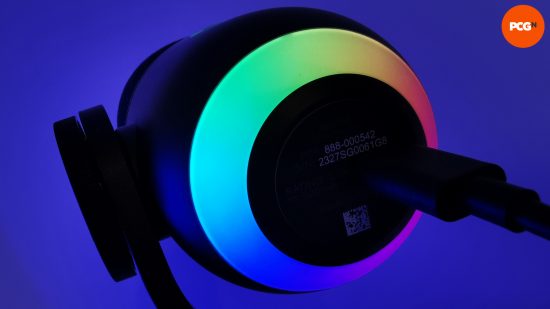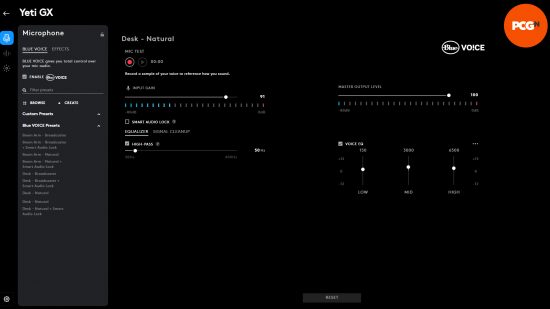Our Verdict
The Logitech G Yeti GX's compact capsule design and ring of RGB lights provides a flashy display for any streaming or gaming setup. Yet this addition to the iconic Yeti line-up has its fair share of flaws, and can't quite live up to expectations set by its higher quality predecessors.
- Compact design
- Customizable ring of RGB lighting
- Unique desktop stand
- No audio monitoring
- Not ideal for purposes outside of streaming/gamin
The Logitech G Yeti GX is the latest addition to the long-running lineup of Yeti microphones that started life under the brand name, Blue, but which have since been swallowed up by the gaming peripheral titan, Logitech. Many of those previous Yeti models were much-loved for their versatility and sound quality, but the new Yeti GX is a much simpler option, just with the addition of RGB lighting.
Well-recognized when it comes to some of the best gaming microphones, any new addition to the iconic Yeti line-up can be anticipated with bated breath. In this case, hopefully, breath can still be picked up with crystal clear clarity that you’d expect from any high-quality microphone. While the Logitech G Yeti GX does its job well enough for what it was intended for, there’s little to make this new entry to the Yeti lineup stand out from the crowd.
Why you can trust our advice ✔ At PCGamesN, our experts spend hours testing hardware and reviewing games and VPNs. We share honest, unbiased opinions to help you buy the best. Find out how we test.
Logitech G Yeti GX specs
| Logitech G Yeti GX Specs | |
| Type | Dynamic |
| Polar Pattern | Supercardioid |
| Connector | USB-C to USB-A |
| Lighting | Dual-zone RGB with LIGHTSYNC |
| Frequency Response | 60Hz-18.5Hz |
Logitech G Yeti GX design
The design of the Yeti GX retains hints of the look of its predecessors, such as the flat-based metal stand and side-mounted, hinged arm, but there’s plenty that’s different too. Instead of that classic, almost retro aesthetic of previous Yeti microphones, the Yeti GX sports a black pill-shaped design, that’s as cute as it is compact.
The microphone itself sits around 5 inches in length, with it reaching just under 7 inches in total with the included desktop stand. On the front-facing side of the device sits the Logitech G logo, which illuminates when the RGB lights are in effect. Below the glowing G logo, and surrounding the circumference of the bottom of the microphone, you can find the pièce de résistance of the Yeti GX – something no gaming hardware in this modern age is seen without – the customizable RGB lighting.
With the help of the accompanying G Hub software, these lights can be customized to play a multitude of animations and are, for all intents and purposes, the main attraction of this new Yeti microphone.
The USB-Type C port is encircled by these lights but is positioned off-center to make way for the curve of the desktop stand. While the position of the power cord is a small nick pick I have with a lot of PC gaming peripherals (I’m looking at you, many gaming keyboards), I like how Logitech intuitively made sure the cable position was slightly to the side, to avoid damage when colliding with the accompanying metal desktop stand.
The stand itself is one of the more unique features of the microphone. Often, microphone stands are pretty uniform, but Logitech has gone for a curved S-shaped stand, which makes it stand out from its contemporaries.
The Yeti GX comes with a small adaptor for ⅝” and ⅜” boom arms, which you can purchase separately, and despite the unique design of the desktop stand, it feels like using an alternative stand is what was intended for this mic. The stand itself isn’t height adjustable, so you need to be leaning in quite close to be in a good position for your voice to be picked up clearly. If you’re tall, that can be uncomfortable. This is hardly a unique problem with this mic – nearly all streaming mics have rather short included stands – but any adjustable boom arm will greatly enhance the comfort and convenience of using this mic.
When the mic is attached to the desktop stand, you also don’t get the full effect of the ring of RGBs, which are so prominent that I doubt Logitech had the intention for them to be hidden from view. Having a boom arm attached would mean you can angle the RGB lighting – and the spectacle they create – to be in full view of your webcam, and your streaming audience.
On the back-facing side of the microphone is a small RGB strip that denotes the ‘Smart Audio Lock’, a scrollable and clickable wheel that helps prevent your audio clipping during recordings, or while streaming. The Smart Audio lock lights up white, green, or red to indicate whether or not your audio is peaking, and by default will light up as cyan to indicate that it’s turned on. Other than the mute button underneath that wheel, that’s it when it comes to buttons or any other manual control.
Logitech G Yeti GX sound quality
The Logitech G Yeti GX is a dynamic microphone with a super-cardioid pickup pattern. What that means is that the Yeti GX is most sensitive to sound coming from the front, least sensitive to sound from the sides, and somewhat sensitive to sound from the back.
This is a sensible choice for a streaming microphone, as the pattern helps prevent any un-wanted room noise sneaking in from the sides, and while the sensitivity to rear noises means any errant flies buzzing in front of your screen could be picked up, most of the time this part of the mic is only facing the quiet expanse of your monitor. What’s more, the construction of this mic means that this sensitivity is masked by the back of the microphone being physically in the way of any sounds coming from the rear. As a result, the Yeti GX does an okay job of damping any unwanted surrounding audio.
However, it’s clear from this mic’s overall sound quality that it is intended mainly for streaming and not much else. Like a lot of middle-aged women, I’m a co-host of a podcast, and when presented with the opportunity to record my audio using the Yeti GX, I opted to stick with my usual Rode microphone instead. Through audio tests, the Yeti GX didn’t provide the same warmth and tone I’d want from recording hours of talking, nor does it come with a pop-shield that would help combat any harsh sounds, though again this is common for streaming/gaming mics and there are plenty of ways to add an after-market pop-shield (though Logitech doesn’t make its own, unlike Elgato with its Elgato Wave mics).
You can improve the sound quality in some respects by turning on ‘Blue VO!CE’, an audio filter found within the G Hub, that increases the gain, and adds some filters, like a compressor, limiter, and ‘de-popper’ to improve the overall sound quality. However, I’d much rather resort to using a better-quality microphone with a physical pop shield attached.
Yet, when playing Dead by Daylight online with my friends, yapping away on Discord, it did the job, making for a clear step up in quality over most headset microphones. That’s so long as I stayed in approximately the same position all evening. Otherwise, I had a stark reminder of why a boom arm is needed to make the Yeti GX truly shine.
Logitech G Yeti GX software
The proprietary software for all Logitech G hardware is ‘Logitech G Hub’, and while it’s not the best accompanying software I’ve ever used, it’s not the worst either. Once you get the G Hub rolling, the free software provides a myriad of customizable options to push the capabilities of your microphone even further, and this opens up the capabilities of the Yeti GX.
It was through the G Hub that I discovered what the Yeti GX is all about. So long as your microphone is plugged in, you’ll see a representation of it on the G Hub splash screen, and once selected, that’s where you’ll be presented with what Logitech’s ‘LIGHTSYNC’ technology has to offer.
All in all, there are seven LIGHTSYNC preset effects available to you from the get-go, varying from a fixed color effect to a pulsating ‘breathing’ animation, to my favorite, the audio visualizer. Exactly as it sounds, the RGB colors change according to the audio playing around you, and through G Hub you even can select exactly what individual colors are being utilized.
If you’re a streamer, this is a wonderful addition, as it means you can specifically pick the colors to match that of your identifying logo or branding, giving your setup that extra “Je ne sais quoi”. Or you can be like me, and change the colors to varying degrees of pink and blast “I’m Just Ken” to see the RGBs change accordingly.
Outside of the presets, you have the ‘freestyle’ option, where you can individually change the color of the G logo on the microphone, as well as the individual RGBs that make up the ring of lighting. You can save your preferred color setup here, or move onto animations, where you can select between any given pre-existing color patterns, or make one of your very own.
The G Hub software isn’t limited to just customizing the RGB lighting of the microphone, as here is where you can also fine-tune the audio quality, as well as get access to the range of ‘Blue’ branded amusing voice effects, and a library of sound samples to use when streaming, or chatting to your friends via platforms like Discord.
It’s a solidly developed piece of software, with all the customizable options laid out in an easy-to-understand way. Whether it’s the microphone equalizer options, voice samples, or the light sync options, each menu is represented by clearly identifiable icons. Although, it doesn’t feel as intuitive as other ones I’ve used, and I do question why there’s a provided library of audio samples, featuring nauseating air horn sounds. Nonetheless, you can’t knock Logitech for providing a robust piece of accompanying software.
Logitech G Yeti GX price
The Logitech G Yeti GX price is $129 / £140, making it a fairly expensive option that offers middling value considering its basic feature set. It can be purchased directly from the Logitech website or via Amazon.
Should you buy the Logitech G Yeti GX?
The Logitech G Yeti GX has a lot to live up to, being a new addition to a beloved line of microphones, some of which I still hear people swear by using even to this day. Yet, the Yeti GX doesn’t quite stand out from the crowd of Yeti microphones that came before it. If you’re looking for a microphone that can do it all, and be used for recording audio, like if you have a podcast talking about the latest PC games, I’d look elsewhere, even through the pre-existing Yeti catalog.
Through getting hands-on experience with the Yeti GX, it’s evident that it was purely designed with gaming and streaming in mind, and there isn’t much room for that to differ. While you can use the G Hub software to push the limits of the audio quality, I wouldn’t rely on the Yeti GX to produce the warmth and clarity of older Yeti microphones you may be more familiar with.
If the Logitech G Yeti GX isn’t for you
If you’re still looking for a gaming microphone compatible with mainstream boom arms, the Elgato Wave:3 might be just what you’re looking for.
If you want your gaming microphone to put on a show, the HyperX QuadCast S is as flashy as it gets. The microphone offers up a full display of RGB lighting, which can help set the mood for all your upcoming streams, or future gaming sessions.




